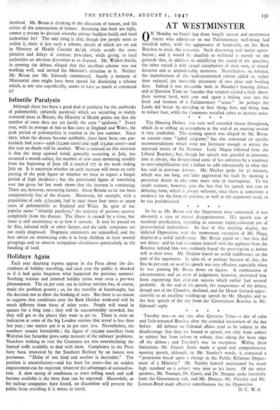Infantile Paralysis
Although there has been a good deal of publicity for the outbreaks of poliomyelitis (infantile paralysis) which are occurring in widely scattered areas in Britain, the Ministry of Health points out that the number of cases does not yet justify the term " epidemic." Every year, with its average of 600 to 800 cases in England and Wales, the peak period of poliomyelitis is reached in the late summer. Since
• 1912, when the disease became notifiable, there have been two par- ticularly bad years-1926 (12,000 cases) and 1938 (15,000 cases)—and this year no doubt will be another. What is unusual on this occasion is that the steep upward trend, generally occurring in July, has occurred a month earlier, the number of new cases mounting steadily from the beginning of June till it reached 177 in the week ending July 19. It is uncertain whether an early increase will mean an early passing of the peak figure or whether we have to expect a longer period .of high incidence ; but the provisional figure of something over 200 given for last week shows that the increase is continuing. There are, however, reassuring factors. Great Britain so far has been comparatively free of the disease. Minnesota, for example, with a population of only 2,750,000, had in 1946 about four times as many cases of poliomyelitis as England and Wales. In spite of the' popular name " infantile paralysis," the majority of patients recover completely from the disease. The illness is caused by a virus, but there is still uncertainty as to how it spreads. It may be passed on by flies, infected milk or other factors, and the early symptoms are not easily diagnosed. Dogmatic statements are unjustified, and the best advice on minimising risks is to keep children in their normal groupings and to observe scrupulous cleanliness—particularly in the handling of food.


































 Previous page
Previous page